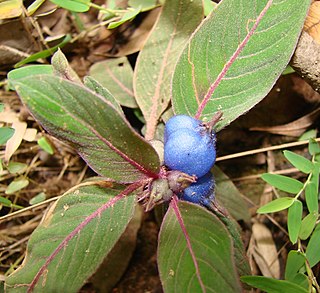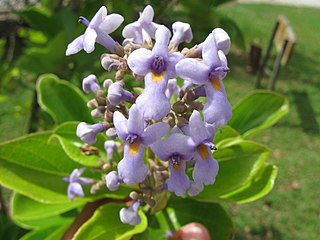| Koanophyllon | |
|---|---|
 | |
| Koanophyllon conglobatum | |
| Scientific classification | |
| Kingdom: | Plantae |
| Clade: | Tracheophytes |
| Clade: | Angiosperms |
| Clade: | Eudicots |
| Clade: | Asterids |
| Order: | Asterales |
| Family: | Asteraceae |
| Subfamily: | Asteroideae |
| Tribe: | Eupatorieae |
| Genus: | Koanophyllon Arruda 1816 |
| Type species | |
| Koanophyllon tinctorium | |
Koanophyllon is a genus of plants in the family Asteraceae. [1] [2] [3] They are perennials and shrubs (rarely vines or trees) and are native to South America, Central America, the West Indies, Mexico, with a few species range extending into the United States. The flowers are white to pinkish (rarely purple). [3]
Cuba alone has 21 endemic species, seven of which only grow in serpentine soils, and some of which accumulate minerals such as nickel and manganese. [4]
- Species [5]
- Koanophyllon adamantium - Brazil
- Koanophyllon albicaulis - from Tamaulipas to Honduras
- Koanophyllon andersonii - Goiás
- Koanophyllon atroglandulosum - Cuba
- Koanophyllon ayapanoides - Cuba
- Koanophyllon baccharifolium - State of Rio de Janeiro
- Koanophyllon barahonense - Hispaniola
- Koanophyllon breviflorum - Cuba
- Koanophyllon bullescens - Cuba
- Koanophyllon cabaionum - Haiti
- Koanophyllon calcicola - Hispaniola
- Koanophyllon celtidifolia - Jamaica, Venezuela, Colombia, Ecuador
- Koanophyllon chabrense - Haiti
- Koanophyllon chalceorithales - Cuba
- Koanophyllon clementis - Cuba
- Koanophyllon coixtlahuacum - Oaxaca
- Koanophyllon concordianum - Sinaloa
- Koanophyllon conglobatum - Brazil
- Koanophyllon consanguineum - southern Brazil
- Koanophyllon constanzae - Dominican Republic
- Koanophyllon correlliorum - Bahamas
- Koanophyllon coulteri - Central America
- Koanophyllon delpechianum - Haiti
- Koanophyllon dolicholepis - Puerto Rico
- Koanophyllon dolphinii - Jamaica
- Koanophyllon droserolepis - Puerto Rico
- Koanophyllon dukei - Panamá
- Koanophyllon eitenii - Goiás
- Koanophyllon ekmanii - Cuba
- Koanophyllon flavidulum - Haiti
- Koanophyllon flexilis - Peru
- Koanophyllon fuscum - Venezuela, Guyana
- Koanophyllon gabbii - Hispaniola
- Koanophyllon galeanum - Nuevo León
- Koanophyllon galeottii - from Veracruz to Nicaragua
- Koanophyllon gibbosum - Hispaniola
- Koanophyllon gracilicaule - Mexico
- Koanophyllon gracilipes - Jamaica
- Koanophyllon grandiceps - Cuba
- Koanophyllon grisebachianum - Dominican Republic, Cuba
- Koanophyllon guerreroanum - Guerrero
- Koanophyllon gundlachii - Cuba
- Koanophyllon hammatocladum - Jamaica
- Koanophyllon hardwarense - Jamaica
- Koanophyllon helianthemoides - Cuba
- Koanophyllon heptaneurum - Dominican Republic
- Koanophyllon hidrodes - Cuba
- Koanophyllon hintoniorum - Nuevo León
- Koanophyllon hondurense - Honduras
- Koanophyllon hotteanum - Haiti
- Koanophyllon huantae - Peru
- Koanophyllon hylonoma - Central America
- Koanophyllon hypomalacum - Guatemala
- Koanophyllon isillumense - Peru
- Koanophyllon iteophyllum - Haiti
- Koanophyllon jaegerianum - Haiti
- Koanophyllon jenssenii - Haiti
- Koanophyllon jugipaniculatum - Bolivia
- Koanophyllon juninense - Peru
- Koanophyllon kavanayense - Venezuela
- Koanophyllon littorale - Cuba
- Koanophyllon lobatifolia - Brazil
- Koanophyllon longifolia - Nuevo León, Tamaulipas
- Koanophyllon maestrense - Cuba
- Koanophyllon mesoreopolum - Colombia
- Koanophyllon microchaeteum - Hispaniola
- Koanophyllon mimicum - Guatemala
- Koanophyllon minutifolium - Cuba
- Koanophyllon miragoanae - Haiti
- Koanophyllon montanum - Jamaica
- Koanophyllon mornicola - Haiti
- Koanophyllon muricatum - Cuba
- Koanophyllon myrtilloides - Brazil
- Koanophyllon nervosum - Hispaniola
- Koanophyllon nudiflorum - Cuba
- Koanophyllon obtusissimum - Dominican Republic
- Koanophyllon oligadenium - Cuba
- Koanophyllon pachyneurum - Hispaniola
- Koanophyllon palmeri - Arizona, New Mexico, [6] Mexico, Brazil
- Koanophyllon panamense - Panamá
- Koanophyllon paucicrenatum - Hispaniola
- Koanophyllon phanioides - Haiti
- Koanophyllon picardae - Haiti
- Koanophyllon pitonianum - Haiti
- Koanophyllon pittieri - from Tabasco to Panama
- Koanophyllon polyodon - Puerto Rico
- Koanophyllon polystictum - Cuba
- Koanophyllon porphyrocladum - Haiti
- Koanophyllon prinodes - Cuba
- Koanophyllon pseudoperfoliatum - Veracruz
- Koanophyllon puberulum - Hispaniola
- Koanophyllon quisqueyanum - Dominican Republic
- Koanophyllon ravenii - Chiapas
- Koanophyllon revealii - Oaxaca
- Koanophyllon reversum - Haiti
- Koanophyllon rhexioides - Cuba
- Koanophyllon rubroviolaceum - Haiti
- Koanophyllon rzedowskii - San Luis Potosí
- Koanophyllon sagasteguii - Peru
- Koanophyllon scabriusculum - Haiti
- Koanophyllon sciatraphes - Venezuela, Hispaniola
- Koanophyllon selleanum - Haiti
- Koanophyllon semicrenatum - Hispaniola
- Koanophyllon silvaticum - Cuba
- Koanophyllon simile - Jamaica
- Koanophyllon simillima - Paraguay, Bolivia, Argentina
- Koanophyllon sinaloense - Sinaloa
- Koanophyllon solidaginifolium - Arizona, New Mexico, Texas, [6] northeastern Mexico
- Koanophyllon solidaginoides - Galápagos, from Tabasco to Peru
- Koanophyllon stipulifera - Bolivia, Argentina
- Koanophyllon subpurpureum - Dominican Republic
- Koanophyllon tapeinanthum - Haiti
- Koanophyllon tatei - Venezuela
- Koanophyllon tetranfolium - Jamaica
- Koanophyllon tetranthum - Jamaica
- Koanophyllon thysanolepis - S Brazil
- Koanophyllon tinctorium - S Brazil
- Koanophyllon tricephalotes - Minas Gerais
- Koanophyllon tripartitum - Chiapas
- Koanophyllon triradiatum - Haiti
- Koanophyllon turquinense - Cuba
- Koanophyllon villosum - Florida, [6] Greater Antilles
- Koanophyllon wetmorei - Panamá, Costa Rica













